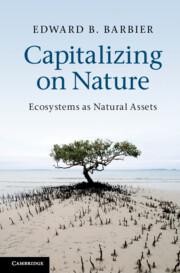Book contents
- Frontmatter
- Contents
- Figures
- Tables
- Boxes
- Acknowledgments
- Introduction
- 1 Ecological scarcity as an economic problem
- 2 Ecosystem services and ecological landscapes
- 3 The basic natural asset model
- 4 Spatial variation in ecosystems
- 5 The open economy
- 6 Ecological collapse
- 7 The way ahead
- 8 Policies in the Age of Ecological Scarcity
- Index
- References
3 - The basic natural asset model
Published online by Cambridge University Press: 05 June 2012
- Frontmatter
- Contents
- Figures
- Tables
- Boxes
- Acknowledgments
- Introduction
- 1 Ecological scarcity as an economic problem
- 2 Ecosystem services and ecological landscapes
- 3 The basic natural asset model
- 4 Spatial variation in ecosystems
- 5 The open economy
- 6 Ecological collapse
- 7 The way ahead
- 8 Policies in the Age of Ecological Scarcity
- Index
- References
Summary
Natural environments will represent irreplaceable assets of appreciating value with the passage of time.
(Krutilla 1967, p. 783)Introduction
The purpose of the following chapter is to illustrate further the natural asset properties of ecosystems by developing a basic competing land use model as applied to ecosystems. As we saw in the previous chapter, if we are to view ecosystems as economic assets, then it is helpful to have a measure of this “ecological wealth.” We suggested that by adopting ecological landscape, or land area, as the basic unit, modeling an ecosystem as a natural asset is relatively straightforward. Here, we also show how this approach facilitates applying competing land use models to the problem of whether or not to conserve or develop the remaining area of an ecosystem.
Employing the concept of an ecological landscape as the basis for analyzing development versus conservation tradeoffs is not new. The many case study examples and valuation studies cited in the previous chapter illustrate that this approach is gaining acceptance in applying integrated ecological and economic analysis to manage entire landscapes, such as floodplains, river basins, watersheds, coastal wetlands, and forests. Integrated economy–ecosystem models in economics have also started examining human transformation of an ecological landscape through land use conversion, leaving the residual land for ecological processes and habitat for species. But whereas these integrated models focus on modeling the complex ecological processes and feedback effects on multiple ecosystem services that arise through land conversion, the approach in the following chapter is to adopt a much simpler model of land use change. Such models of competing land use have been employed in many contexts to analyze the allocation of land between alternative uses.
- Type
- Chapter
- Information
- Capitalizing on NatureEcosystems as Natural Assets, pp. 85 - 128Publisher: Cambridge University PressPrint publication year: 2011



